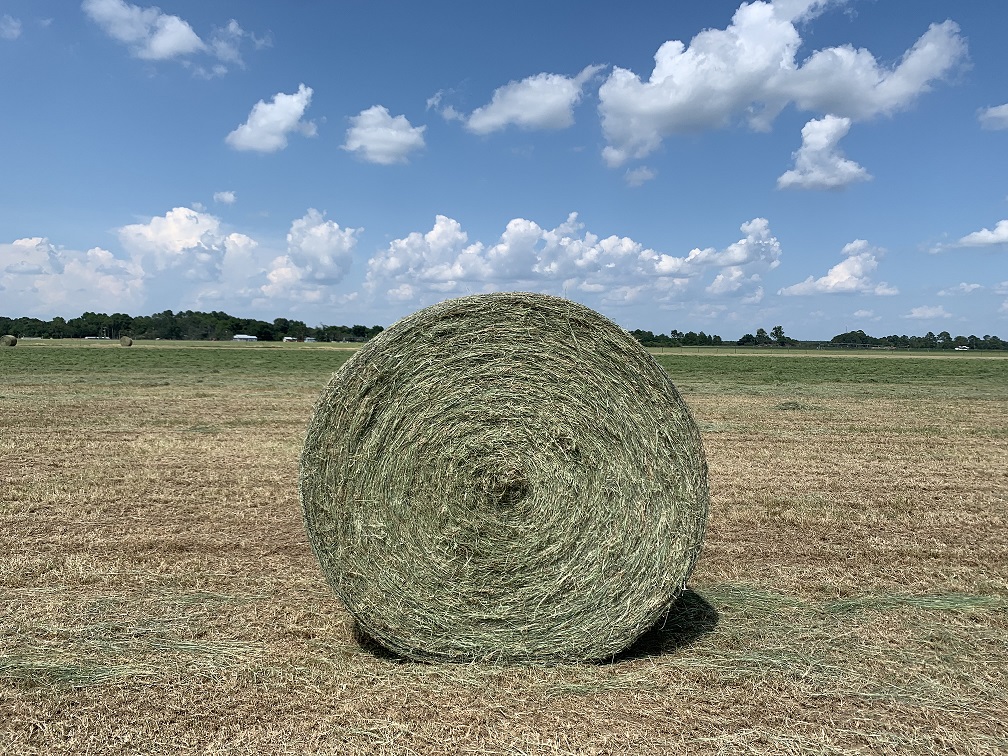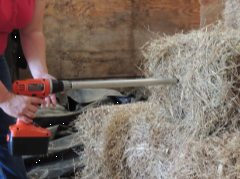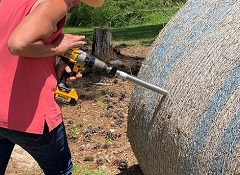
How to Sample Hay and Baleage
Test each lot of forage separately. A lot is defined as hay that was managed the same and harvested at the same time, out of the same field, and under the same conditions.
A forage analysis is only as good as the sample collected. For best results, collect a representative sample by following these guidelines:
Dry Hay


- Using a hay coring probe, collect 15–20 cores from each lot.
- To collect a core, insert the hay probe on the side of the bale, coring toward the center so you cross several windrows.
- Remove the hay probe and empty the contents into a clean container (e.g., bucket or bag).
- Mix the material thoroughly to decrease bias. Pour in enough sample to fill a 1-quart plastic bag.
- Label each sample to make it easy to remember the location and lot sampled.
- Fill out the UGA Feed and Forage Testing Application, attach the form to the sample, and submit to your UGA County Extension Office.
Baleage
Baleage samples may be collected:
- After baling, before wrapping: Collect core samples just before wrapping, using the dry hay protocol.
- After wrapping: Collect core samples from various locations in one tube or several individually wrapped bales from the same lot. Ideally, this would occur post-fermentation (6+ weeks after wrapping).
- Just before feeding: Collect core samples from the tube or lot of bales that you plan to feed next. This decreases potential spoilage caused by hole punctures.
When sampling baleage:
- Seal the puncture hole in the bale immediately after coring with two pieces of UV-protected silage tape layered across each other to form an “X”.
- Remove as much air as possible from the sample bag before sealing.
- Ship baleage samples to the lab immediately. Collect and ship samples early in the week to reduce the chance of spoilage between collection and analysis.
How to Read a Forage Test Report
A forage test is one of the most valuable tools a producer has available. It is important to understand the terms on the report so you can interpret the results correctly.
As Sampled vs. Dry Matter: Which Do I Use?
A forage test will have two different numbers listed for each measure of forage quality. To compare numbers and ration balancing, use the numbers for dry matter.
Key Terminology from NIR Analysis
A forage test contains a lot of valuable information, but here are the main points of interest to producers.
Relative forage quality (RFQ): A calculation used to rank forages according to their relative nutritive value (see Table 1).
| Class | RFQ Range |
|---|---|
| Heifer, 3–12 months | 125–140 |
| Heifer, 12–18 months | 115–130 |
| Heifer, 18–24 months | 100–115 |
| Dry cow | 100–115 |
| Stocker cattle | 125–140 |
| Lactating beef cow | 115–130 |
| Dairy calf | 140–160 |
| Dairy, first 200 days | 140–160 |
| Dairy, last 200 days | 125–140 |
| Idle horse | 100–115 |
| Brood mare | 110–125 |
| Nursing mare | 120–135 |
| Working horse | 110–125 |
| Hard-working horse | 120–135 |
Total digestible nutrients (TDN): A calculation of the energy value of the forage.
Neutral detergent fiber (NDF): A close estimate of the total fiber constituents of feedstuffs; this is negatively correlated to dry-matter intake.
Acid detergent fiber (ADF): Represents the least-digestible fiber portion and is used to calculate digestibility measures.
Acid detergent fiber (ADF): Represents the least-digestible fiber portion and is used to calculate digestibility measures.
Crude protein: Represents total nitrogen (including nitrates; see Table 2).
| Forage nitrate (ppm) | Strategy |
|---|---|
| < 4,500 | safe to feed |
| 4,500–6,500 | limit to 1/2 ration for pregnant animals |
| 6,500–9,000 | limit to 1/2 ration |
| 9,000–15,000 | limit to 1/3 ration |
| 15,000–18,000 | limit to 1/4 ration |
| > 18,000 | potentially lethal, use carefully |
†Nitrates accumulate in forage with excessive nitrogen fertilization and stress that limits growth (e.g., moisture stress).
Forage Test Report Example
How to Use a Forage Test Report to Make a Winter Feed Plan for Beef Cattle Producers
Producers should follow these steps to develop a plan for winter feeding ahead of time and avoid trouble during the breeding season:
- Understand the cows’ stage of production.
- Cows should be rebred within 80–90 days postcalving to maintain a 365-day calving interval.
- If the available forage does not meet a cow’s basic nutrient requirements, she will breed later in the season. The basic requirements are outlined below.
- Understand the available forages. Ask the following questions:
- How many bales of hay are available? How much does each bale weigh?
- What is the nutritive value of the hay? Have you tested each lot of hay?
- How long does the hay need to last?
- Develop an economical supplementation strategy to address nutrient deficiencies.
- Evaluate available supplements carefully. They are not all created equally.
- Evaluate the price of supplements on a dry-matter basis. Look at the cost per nutrient.
- Utilize a program (e.g., UGA Basic Balancer) to accurately develop diets.
| Stage of production | DMI % of bw | CP % | TDN % |
|---|---|---|---|
| Dry cow | 1.86 | 7 | 48 |
| Late gestation | 1.86 | 8 | 53 |
| Peak lactation | 2.00 | 11 | 60 |
| Late lactation | 2.13 | 9 | 55 |
|
Note. Required nutrients will increase or decrease if the animal weighs more or less than 1,200 lb. From “Nutrient Requirements of Beef Cattle, 8th Revised Edition,” 2016, National Academies Press (www.doi.org/10.17226/19014). |
|||
Match Hay to Cow’s Nutrient Requirements to Reduce Costs.
Reduce supplementation needs by feeding the best forage when the cow’s requirements are the greatest. Numbers will change based on the feed source. Work with your local Extension agent to develop cows’ diets.
| Stage of Production | Cutting 1 7% CP 48% TDN |
Cutting 2 9% CP 54% TDN |
Cutting 3 12% CP 60% TDN |
|---|---|---|---|
| lb supplement required | |||
| Dry cow | 0 | 0 | 0 |
| Late gestation | 4 | 0 | 0 |
| Peak lactation | 10 | 6 | 0 |
| Late lactation | 6 | 0 | 0 |
|
Note. Assuming 50:50 corn gluten feed and soybean hulls used as supplementation. |
|||
Status and Revision History
In Review on Feb 07, 2024
Published on Feb 28, 2024


























































